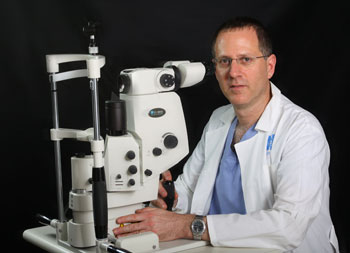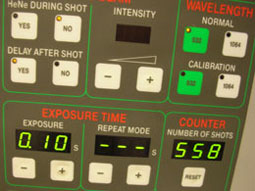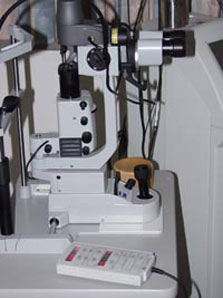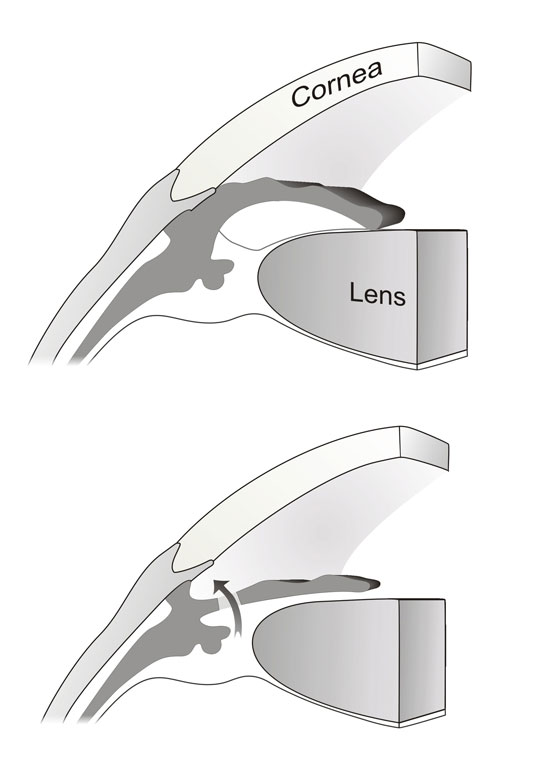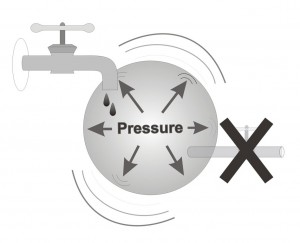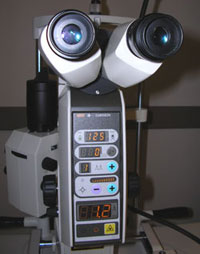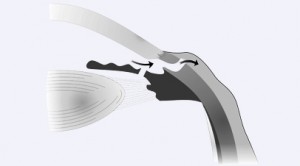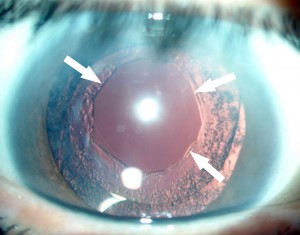Several different laser treatments exist for the treatment of glaucoma. Different lasers omit laser light with different properties
are used to perform these various laser treatments.The la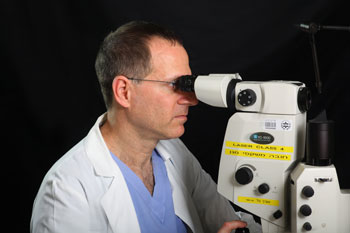 ser treatment for open-angle glaucoma is called trabeculoplasty. This treatment is often called, in short: ALT, LTP, SLT. Its purpose is to increase drainage of the fluids of the eye (called aqueous humor) by improving the drainage system that leads fluid out of the eye, and, as a result, the pressure is reduced. The treatment takes place in the laser room at the eye clinic and usually takes about 15-20 minutes. It is usually possible for the patient to go home approximately one hour after the treatment (there is no need for hospitalization or an extended stay at the clinic). Following the laser treatment, the patient continues to take the same eye drops that he or she was were taking to help lower intra-ocular pressure. This laser surgery is likely to lower intra-ocular pressure in 3 out of 4 cases (about 75% of patients). It is an important treatment modality, however, it is not a perfect solution for the disease and the pressure is liable to rise again in about half of patients within approximately 5 years. It is possible to repeat this treatment at some point in time in the future, often with similar success rates.
ser treatment for open-angle glaucoma is called trabeculoplasty. This treatment is often called, in short: ALT, LTP, SLT. Its purpose is to increase drainage of the fluids of the eye (called aqueous humor) by improving the drainage system that leads fluid out of the eye, and, as a result, the pressure is reduced. The treatment takes place in the laser room at the eye clinic and usually takes about 15-20 minutes. It is usually possible for the patient to go home approximately one hour after the treatment (there is no need for hospitalization or an extended stay at the clinic). Following the laser treatment, the patient continues to take the same eye drops that he or she was were taking to help lower intra-ocular pressure. This laser surgery is likely to lower intra-ocular pressure in 3 out of 4 cases (about 75% of patients). It is an important treatment modality, however, it is not a perfect solution for the disease and the pressure is liable to rise again in about half of patients within approximately 5 years. It is possible to repeat this treatment at some point in time in the future, often with similar success rates.
Besides the laser treatment described above, there are other laser treatments that can be used in specific situations, such as closed-angle glaucoma, as well as other kinds of glaucoma. What is common to all these laser treatments is that they are performed in the clinic following gentle anesthesia achieved using numbing eye-drops, with almost no pain felt during the actual laser session. The patient can usually return home after an hour or two and almost immediately resume full activity (including going to work the following day).
These laser treatments treat the inside of the eye without necessitating invasive surgery, nor surgical entry into the eye, and without requiring the sterile conditions of an operating room.
The question arises: which patients are suited for laser surgery and which for an operation? The answer is that the decision is, indeed, not an easy one and usually can only be made after a thorough examination of the patient by the doctor who performs such surgeries. Numerous factors are used to establish a treatment decision. Consequently, a treatment plan is designed for each patient based on the type of glaucoma, the intra-ocular pressure values, the structure of the eye, as well as specific findings on eye examination, the severity of damage to the optic nerve and the visual field, the patient’s age and a wide range of additional factors (such as the existence of additional diseases in the eye, the condition of the lens (is there a cataract), diabetes and the appearance and function of the area of the eye responsible for drainage).
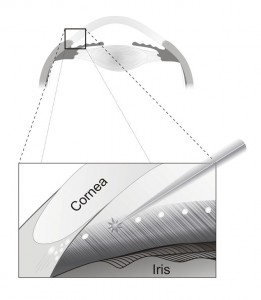 Many glaucoma patients are concerned, or even scared, about the option of laser treatment. A comprehensive explanation generally succeeds in putting these fears to rest; however, it is only natural for a patient to be concerned about a surgical procedure to be performed on one’s eyes. It is important to note that laser treatments for glaucoma are generally safe and the associated risks are very low, when the treatment is done by an experienced glaucoma specialist who specializes in these treatments modalities.
Many glaucoma patients are concerned, or even scared, about the option of laser treatment. A comprehensive explanation generally succeeds in putting these fears to rest; however, it is only natural for a patient to be concerned about a surgical procedure to be performed on one’s eyes. It is important to note that laser treatments for glaucoma are generally safe and the associated risks are very low, when the treatment is done by an experienced glaucoma specialist who specializes in these treatments modalities.
In summary: laser treatments, are used routinely for the treatment of glaucoma, and have been in existence for over 40 years. With time they have constantly evolved into sophisticated treatment modalities that greatly improve our ability to control glaucoma, and occasionally fix limitations in eye structure that would otherwise lead to exacerbation of glaucoma had they not been corrected. An explanation about the type of treatment that you have may alleviate many fears, and the knowledge that the procedure will be carried out by an expert doctor with experience ensures the best chance for maximal success of the procedure.
